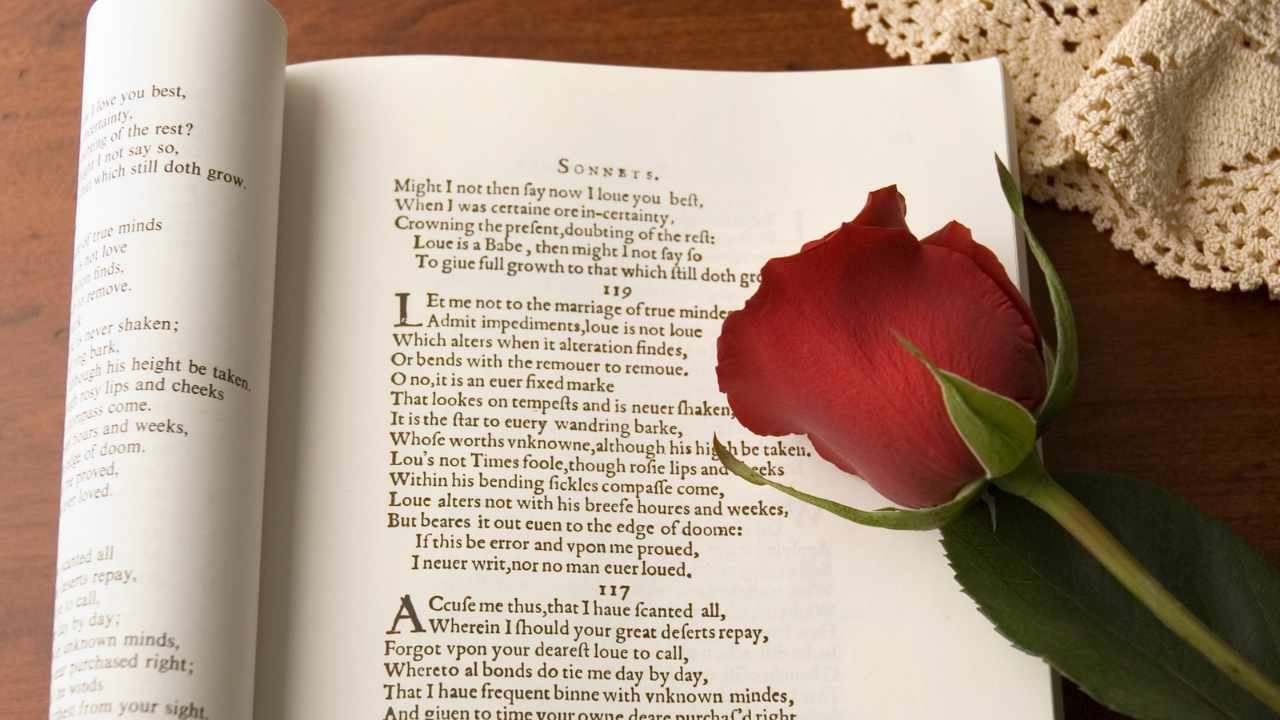Are you feeling poetical? Are you struggling to pen a Petrarchan or Shakespearean sonnet that will make the ladies swoon? Fear not, intrepid wordsmith! This guide teaches you how to write a sonnet. Let’s get started!
What is a sonnet?
A sonnet is a 14-line poem that follows a strict rhyme scheme and iambic pentameter meter. The sonnet form was invented in the 13th century by the Italian poet Giacomo da Lentini, though the term “sonnet” wasn’t used to describe it until the 16th century.
Shakespeare popularized the form in English with his famous 154-sonnet sequence, which includes some of the most well-known poems.
Today, sonnets are still written in various languages and generally convey a deep emotional connection between the speaker and their subject. Above all, they are intended to be beautiful works of art that can be enjoyed for centuries.
Three main types of sonnets.
The Petrarchan sonnet, also known as the Italian sonnet, is the kind most commonly associated with love poetry. It is named after its creator, the fourteenth-century Italian poet Francesco Petrarca. Petrarchan sonnets typically feature two quatrains (four-line stanzas) followed by two tercets (three-line stanzas), with the volta occurring between the eighth and ninth lines. The rhyme scheme is usually abbaabba cdecde or abbaabba cdcdcd.
The Shakespearean sonnet, also known as the English sonnet, is perhaps the best-known type of sonnet in the English-speaking world. It was popularized by none other than William Shakespeare himself, who wrote 154 of them! Shakespearean sonnets follow a different structure to Petrarchan sonnets: three quatrains followed by a couplet, with the volta coming after the eighth line. The rhyme scheme is usually abab cdcd efef gg.
The Spenserian sonnet takes its name from Edmund Spenser, a sixteenth-century English poet best known for his epic poem The Faerie Queene. Spenserian sonnets are similar to Shakespearean sonnets, but with a slightly different rhyme scheme: abab bcbc cdcd ee. The volta also generally occurs between the ninth and tenth lines, rather than the eighth and ninth.
Others have read: How to Write a Love Song: A Step-By-Step Guide
Sonnet examples
Sonnets are one of the most well-known and beloved forms of poetry in the literary world. Whether expressed through a playful rhyme scheme or a poignant message, a sonnet has the power to convey deep emotion and resonate with readers for years to come.
One of the most compelling examples of a sonnet is Maya Angelou, who expressed her love for God through vivid imagery and dignified language. In her poem “When You Come,” she describes the sun as “a rose gold flame” that warms her heart and calls out to her soul:
In golden light, I saw my god, resplendent with radiance strong. His mighty hand reached out and called me home, his glory bright like the dawn.
Thus transformed by his divine embrace, my body warm within his arms, secure in him, i sing this final adieu to sorrows left below at long last free! His endless spirit now lives on in me…Forever poetically this soul shall soar upon wings divine.
We can see just how powerful and profound a sonnet can be through this moving depiction of nature’s majesty. Whether simple or complex, it taps into the deepest parts of our hearts and reveals our most genuine feelings.
So if you are looking to express your own passions, struggles, or emotions through poetry, consider writing a sonnet! With its strict rhyme scheme and iambic pentameter metre, this classic form of poetry can help you create a work of art that will delight and inspire readers for years to come.
Also related: How to Write Manifestations
How to write a sonnet
A sonnet is a 14-line poem with a specific rhyme scheme. It is traditionally written in iambic pentameter, which means each line has 10 syllables with the stress falling on every second syllable.
There are two main types of sonnets: the Petrarchan sonnet, which is divided into an 8-line octave and a 6-line sestet, and the Shakespearean sonnet, which is divided into three quatrains and a couplet. The Shakespearean sonnet is the most common type of sonnet in English. If you want to write a sonnet, follow these steps:
1) Choose a subject for your sonnet. This could be something you feel strongly about or something that has personal meaning for you.
2) Decide what kind of sonnet you want to write. As mentioned above, there are two main types of sonnets: the Petrarchan and the Shakespearean. If you’re unsure which one to choose, try writing one of each to see which style suits your voice and subject best.
3) Start by drafting the octave (the first 8 lines). This should introduce your subject and set up the problem or tension that you want to explore in your poem.
4) Next, write the sestet (the final six lines). This is where you will resolve the problem or tension from the octave and explore the deeper themes or ideas in your poem.
5) When you are done writing, go back and revise and edit your sonnet for clarity, imagery, and tone. Remember to use precise language that evokes strong emotion and creates a vivid picture in the reader’s mind.
6) Lastly, share your finished sonnet with the world! You can submit it to publications, post it online, or share it with your friends and family.
Sonnets are still written in various languages and convey a deep emotional connection between the speaker and their subject. Above all, they are intended to be beautiful works of art that can be enjoyed for centuries to come. So if you want to create your own masterpiece, start writing a sonnet today!
An interesting read: How To Write Playful Banter
Sonnet tips
Writing a sonnet can be a fun and challenging exercise, and keep a few tips in mind if you want to create effective and beautiful verse.
First, you need to be sure that your subject matter is worthy of the form. This means choosing topics that are meaningful or thought-provoking rather than just simple reflections on everyday experiences.
Secondly, aim for a variety of imagery throughout your sonnet.
Use colorful, descriptive language to convey different moods and emotions, and take time to play around with poetic devices such as metaphors and alliteration.
And finally, remember that it is okay to experiment with structure. Whether you choose to stick with the traditional iambic pentameter or try out new patterns of rhyme and rhythm, never be afraid to push the boundaries of traditional sonnets. With these tips in mind, you’ll be well on your way toward writing powerful and memorable poetry!
Take a look: How to Write a Fairy Tale
Sonnet resources
Shakespeare’s Sonnets – This website provides a complete analysis of Shakespeare’s sonnets, with each one conveniently numbered and searchable by subject matter. If you’re looking better to understand the language and form of the sonnet, this is a great resource.
Sonnet Central – This website collects sonnets from a variety of poets, both classic and contemporary. You can browse by poet or theme, making it easy to find sonnets that speak to you. There are also several resources for writing your sonnets if you feel inspired.
The Sonnet Board – This online forum is a great place to discuss all things sonnets, from favorite poems to tips for writing your own. You can also find links to poetry contests and other opportunities here. Whether you’re a seasoned pro or just getting started, the Sonnet Board is an excellent resource for anyone interested in this versatile and timeless form.
The best way to learn about sonnets is to read as many as possible. Start with the greats like Shakespeare and Donne, then branch out to modern poets like Maya Angelou and Anne Sexton.
As you read, pay attention to how the poets use language to create mood and meaning. Also, notice how the strict structure of the sonnet can either enhance or hinder the overall effect. With time and practice, you’ll be able to write sonnets of your own that are both beautiful and powerful.
Another article to read: 15 Memoir Writing Tips for Beginners: Secrets to a Bestseller
FAQ
How many couplets are in a Sonnet?
There is one couplet in a sonnet. The couplet serves as the final lines of both the octave and sestet, providing a resolution or conclusion to the poem. It is also where more abstract themes or ideas are explored in greater depth. Additionally, some sonnets may only have three quatrains, with no couplet.
How many feet are in a Sonnet?
There are five feet in a sonnet. The most common meter is iambic pentameter, which means there are five iambic feet per line. Iambic pentameter is often considered the natural rhythm of speech, and it gives the sonnet a flowing, conversational quality. However, there are many varieties of a sonnet that use different types of meter, so feel free to experiment and find a rhythm that works for your poem.
What is a Petrarchan Sonnet?
A Petrarchan sonnet is a type of sonnet that originated in Italy during the Renaissance. It is named after the poet Petrarch, who popularized this form of poetry.
Petrarchan sonnets are divided into two stanzas: an octave (eight lines) and a sestet (six lines).
The octave contains the problem or question, while the sestet offers a resolution or conclusion. Additionally, Petrarchan sonnets have a strict rhyme scheme of abbaabba cdecde.
Can a Sonnet have 15 Lines?
Yes, a sonnet can have 15 lines. This is known as an extended or Shakespearean sonnet, and it is the most common type of sonnet today. Shakespearean sonnets consist of three quatrains (four lines each) followed by a couplet (two lines).
The rhyme scheme is usually abab cdcd efef gg, although some variations are common. With its longer length and more complex rhyme scheme, the Shakespearean sonnet is often considered the most challenging form of poetry. However, you can master this versatile poetic form with practice and patience.
Do Sonnets have Stanzas?
Sonnets typically have stanzas, although there are some exceptions. Stanzas help to divide the poem into manageable sections and can also create a sense of rhythm or meter.
The most common type of sonnet is the Shakespearean sonnet, which has three quatrains (four lines each) followed by a couplet (two lines). However, there are many other variations of sonnets that use different numbers and types of stanzas.
What is the difference between a Sonnet and a Haiku?
The main difference between a sonnet and a haiku is the length and structure of each poem. A sonnet is typically 14 lines long and follows a specific rhyme scheme and meter, while a haiku is much shorter, usually only three lines.
Additionally, sonnets are more complex in terms of theme and language, exploring deeper themes through rich imagery and metaphors. On the other hand, Haiku are typically more simplistic, focusing on one image or moment in time.
What is the difference between a Sonnet and a Limerick?
The main difference between a sonnet and a limerick is their respective structures.
A sonnet is a 14-line poem that follows a specific rhyme scheme and meter, while a limerick is a five-line poem with a more irregular rhyme scheme.
Additionally, sonnets are typically more formal and serious in tone, while limericks often have a more light-hearted or humorous manner.
What is the difference between a Sonnet and an Ode?
An ode is a poem that typically expresses deep admiration or praise for a person, object, idea, or concept.
A sonnet is also a poem, but it is shorter and more structured than an ode. Sonnets have a specific rhyme scheme and meter, while odes do not necessarily follow any particular rules or conventions.
Additionally, odes are typically more personal in nature, while sonnets are often more universal and can be about a wide range of topics. Ultimately, the choice to write an ode or a sonnet depends on your preferences and goals as a poet.










